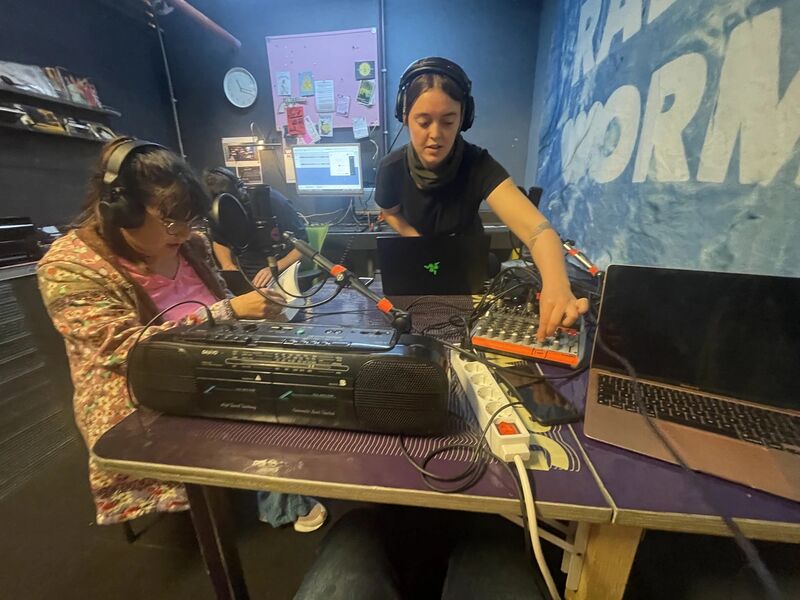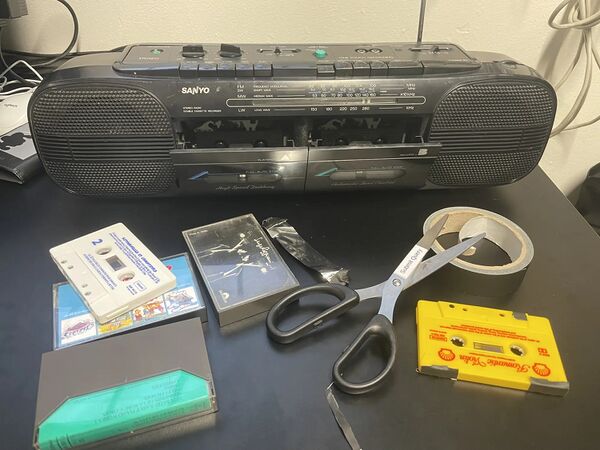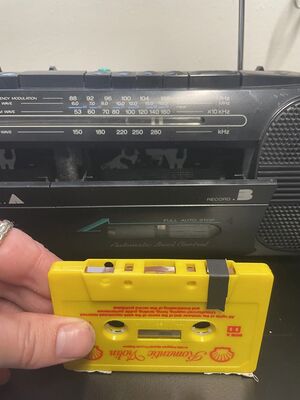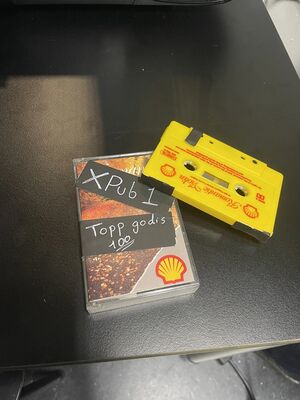User:ØverLørd/Special Issue 22: Difference between revisions
(→Broadcast #1: added images, revised text) |
(added image for bc 7 and embedded audio-files) |
||
| Line 54: | Line 54: | ||
===Personal Accounts of Irreplaceable Lace: a 200 year old history of Lost and Found=== | ===Personal Accounts of Irreplaceable Lace: a 200 year old history of Lost and Found=== | ||
Discussions around archival practices were helpful to inform a fiction, a | Discussions around archival practices were helpful to inform a fiction, a radio-play in three acts. Written collaboratively with Senka and Riviera, utilizing the exquisite corpse strategy. A protocol for working together, where everyone is given a limited time to work on something, and then have to pass it on to the next contestant, who shall then pickup where the initial person was cut off. This proved to be an effective strategy for generating the fiction, and with a couple of rounds of readings, writings and discussions, we had made a draft of a fiction that concerns three archivists in the same institution, in the past present and future. This resonates with the archives potential to bridge waste cases of time. Another big theme in this fiction is types of media, where we create speculative materials that questions and resonates with different aspects of the durability of archives and archived media. | ||
[[File:Broadcast-7.jpg|600px]] | |||
<br style="clear:both;"> | |||
<small>Picture from the performing of the radio-play in the studio</small> | |||
<br><br> | |||
To allow for a collaborative process on creating the fiction we decided on a structure where we wrote multiple "diary"-entries to convey the story. To emphasize this devision some jingles to play before each entry were devised. The jingles were created audacity, cutting, stretching, tweaking and modulating sounds. The source material was a digital recording of a mix-tape tape-roll beeing wound and unwound, accompanied by "found sounds" (recorded plotter-sounds). The windings of the tape roll speak of time, and the mechanical noise of the plotter construct a curious and inventive atmosphere. | |||
{{audio|mp3=https://pzwiki.wdka.nl/mw-mediadesign/images/7/79/Pastjingle.mp3 | |||
|style=width:100%}} | |||
{{audio|mp3=https://pzwiki.wdka.nl/mw-mediadesign/images/0/0d/Presentjingle.mp3 | |||
|style=width:100%}} | |||
{{audio|mp3=https://pzwiki.wdka.nl/mw-mediadesign/images/c/c1/Futurejingle.mp3 | |||
|style=width:100%}} | |||
===Interview with Ari=== | ===Interview with Ari=== | ||
Revision as of 23:29, 31 March 2024
Personal Notes on Special Issue 22:
Protocols for an active archive
Through SI22 protocols for an active archive we explored community radio and community archives… We made broadcasts through sound experiments, interviews and, fiction… And in prototyping we played around with forgotten media, made soundboards radio-transmitters …
highlights from SI22:
Broadcast #1

Picture from the studio @ radio worm, During the first broadcast
Initially we played a 20 minute recording by Udo from radio Aporee, where he introduces the Radio aporee project. This gave us some to to get familiar with the equipment, and set up in the studio. It also served as a nice segway into the next planned section of the show: the field recordings the group collectively made the day before.
After the recording was finished we gave a brief introduction to Xpub by reading the course description of the wiki page.
In order to activate the archive of the field recordings memory task, we used two computers and live-mixed the recordings utilizing the built in play back features of the wiki. This included changing the playback speed as well as playing different recording simultaneously. During this live-mixing-experiment another experiment was carried out in the studio: a field recording of the studio was made, which we then broadcasted.
The next segment of the broadcast, we played the pre-recorded mix-tap Riviera and Victor made the day before. We also gave a brief explanation on how the mix-tape was made.

The Setup used to make the mixtape
The mixtape was made using a cassette-tape-player/recorder/radio, a box of cassette-tapes, some tape and a pair of scissors. The cassette-player have two compartments for loading cassettes. one for recording and one for playing, while recording, whatever is being played-back will be recorded on the cassette. This way it is possible to record snippets of radio, or music from other cassettes, and compile them into "sonic landscapes". One thing to note is that to record over already recorded casettes, the holes on the bottom needs to be taped over. This is a security feature to ensure that people don't accidentally ruin their favorite ABBA-tape with a weather-forecast
The relatively limited interface of the device determined the rules for what play was possible.
Some techniques that were devised during this experiment:


The finished mixtape, with tape covering erase head, and it's casing
In another section of the broadcast Maria read excerpts from a book, during this section we started experimenting with the different equipment we hade connected. Creating a landscape with the help of the tape-player, computer and mixing-table.
The experience of being in the studio was very interesting, with little to no experience with similar equipment the broadcast became explorative and expermental. A common theme for this broadcast could maybe be activating archives, as this was at the core of our approach. To utilize different tools to source different materials, and the play them back in various ways. Different archives activated in this session were: Radio Aporee, memory archives of the Xpub students, Old cassettes, a book, Ai jingle.generator and Youtube. Activating and iterating over different sourced materials, is a potent way of crating content, whilst also raising question regarding authorship and materiality
Personal Accounts of Irreplaceable Lace: a 200 year old history of Lost and Found
Discussions around archival practices were helpful to inform a fiction, a radio-play in three acts. Written collaboratively with Senka and Riviera, utilizing the exquisite corpse strategy. A protocol for working together, where everyone is given a limited time to work on something, and then have to pass it on to the next contestant, who shall then pickup where the initial person was cut off. This proved to be an effective strategy for generating the fiction, and with a couple of rounds of readings, writings and discussions, we had made a draft of a fiction that concerns three archivists in the same institution, in the past present and future. This resonates with the archives potential to bridge waste cases of time. Another big theme in this fiction is types of media, where we create speculative materials that questions and resonates with different aspects of the durability of archives and archived media.

Picture from the performing of the radio-play in the studio
To allow for a collaborative process on creating the fiction we decided on a structure where we wrote multiple "diary"-entries to convey the story. To emphasize this devision some jingles to play before each entry were devised. The jingles were created audacity, cutting, stretching, tweaking and modulating sounds. The source material was a digital recording of a mix-tape tape-roll beeing wound and unwound, accompanied by "found sounds" (recorded plotter-sounds). The windings of the tape roll speak of time, and the mechanical noise of the plotter construct a curious and inventive atmosphere.
Interview with Ari
To learn more about archival practices for the SI interviews were conducted. Together with Thijs I interviewed the in-house archivist at worm, Ari. Who manage the massive archive of worm, swell as the Pirate Bay. This archive is mainly composed of different media donated by people in and around the community. In this conversation we were trying to figure out what makes an archive, and we learned that managing access is an important part of archival practices. What is the point of a sweet pokemon-card collection if nobody gets to see it right? It is in the interaction with a community an archive comes to life.
Other questions raised in the interview and in the working with the SI22 regarding archival practices were: what to archive?
When the Voyager 1 launched in 1977 it brought along a golden plate. Recorded on this golden plate is a plethora of images and sounds that intend to depict the diverse life on earth. But If anyone is to come across this record, how would they know how to read it? Or for the matter of fact even know it can be read? Luckily the eggheads at NASA thought of this and included a record player with it, as well as instructions on how to read it. (Trying to explain 70s' digital tech to aliens lol) The voyagers fate is probably one of desolation, but it raises the question about storage formats. And how it's not necessarily enough to just produce records, and take it for granted that .mp3 files is a fundamental constant that everyone will forever enjoy. In other words, archival practices also entail maintaining the knowledge and means of (re)production. A first hand encounter with these kinds of concerns was at worm, where they work with chemical film production(?), techniques used to make blockbusters for half a century, now obsolete in the CGI-paradigm of filmmaking today. A lot of the knowledge have already been lost to time, so at worm they are experimenting in order to (re)discover the medium, whilst keeping it alive. Another aspect to the challenges of working with obsolete media is the fact that it might be hard to come by, as .com-bubble already burst and the factory is bankrupt.
fragmented recollections:
monday 18/9
This day started with a tour at worm. We got to see the different workstations, the studios and the different event spaces. The highlight of this tour was to see the radio-studio, which we were going to occupy for the following weeks. I think it is very nice that we can get introduced to the creative communities, which breathe life into the the cultural scene of Rotterdam.
When we got back to school we discussed the concept of post-digital as it is at the core of the study-programme´s philosophy and approach to art and design.
From my understanding the concept envelopes how processes and relations are mediated and conducted through a multiplicity of various channels that can be both digital, mechanical or human. Understanding these interfaces between different nodes in a network bears a lot of potential for exploration and experimention.
To further explore this concept we were introduced to a tape-recorder-and-player which could could record and was a suggested tool for creating material for our radio broadcast.
To start exploring the theme of this Special Issue we had got a small task related to field recordings. The task was to use radio aporee´s field recording archive, and find a recording that provoked a memory. Then we recorded ourselves talking about this memory in one recording, and read the meta-data of the origianl field recording in another.
Finally the task called for us to compile these three recordings in a wiki page.
This task taught us how to activate an archive, and how one can interact and iterate over information available. In this task there were multiple archives being activated: radio aporees field recording archive, our personal archive of memory, and the wiki-archive of the PZI.
Another theme of the Special Issue was discussed, the theme of protocols, therefore the group discussed different protocols for how the radio broadcast at worm could be carried out. Since our first broadcast was the following day, one of the most urgent questions was who was going to be in the studio for this first day. The group agreed that Bernadette, Maria and Victor was going to be the first group of caretakers to inhabit the Radio Worm Studio. As preparation for the first broadcast Riviera and Victor experimented with the tape-player/recorder, by covering the erase-head of the device, they were able to layer different recordings on top of each other. The different recordings collaged came from the radio, and a box of tapes from a flea marked.
Tuesday 19/9
This was the day of the first broadcast, with Bernadette, Maria and Victor as the caretakers.
Initially we played a 20 minute recording by Udo from radio Aporee, where he introduces the Radio aporee project. This gave us some to to get familiar with the equipment, and set up in the studio. It also served as a nice segway into the next planned section of the show: the field recordings the group collectively made the day before.
After the recording was finished we gave a brief introduction to Xpub by reading the course description of the wiki page.
In order to activate the archive of the field recordings memory task, we used two computers and live-mixed the recordings utilizing the built in play back features of the wiki. This included changing the playback speed as well as playing different recording simultaneously. During this live-mixing-experiment another experiment was carried out in the studio: a field recording of the studio was made, which we then broadcasted.
The next segment of the broadcast, we played the pre-recorded mix-tap Riviera and Victor made the day before. We also gave a brief explanation on how the mix-tape was made.
In another section of the broadcast Maria read excerpts from a book, during this section we started experimenting with the different equipment we hade connected. Creating a landscape with the help of the tape-player, computer and mixing-table.
The experience of being in the studio was very interesting, with little to no experience with similar equipment the broadcast became explorative and expermental. A common theme for this broadcast could maybe be activating archives, as this was at the core of our approach. To utilize different tools to source different materials, and the play them back in various ways. Different archives activated in this session were: Radio Aporee, memory archives of the Xpub students, Old cassettes, a book, Ai jingle.generator and Youtube. Activating and iterating over different sourced materials, is a potent way of crating content, whilst also raising question regarding authorship and materiality
After the broadcast we went on a visit to a gallery called Mama, where a previous Xpub student had organized an exhibition. The exhibit was focused around sensor technology and the IoT that permeates life in late-capitalist urban environments. More specifically there is a project in the makings, where the government in Rotterdam are introducing lamp posts with wifi, so they can connect to your phone and track your every move, all in the name of security and sustainability. The exhibit problematized how these technologies come with great ethical implications relating to surveillance and social control of the city´s inhabitants. It did this by framing the IoT ecosystem as this autonomous ecosystem, with trash-can clams and toy hamsters.
After the gallery visit a session in prototyping was the next up on the agenda. In this session we set up a Pi-server using ssh(I think). After creating our users and getting a brief introduction to how to communicate with the server through the terminal, we connected a line printer. This line-printer prints every line of text posted to the wall of the server. During this i printed a lot of ascii-art horses made with an online tool. It was and interesting experience in how we can collectively/collaboratively work through the server.
Wednesday 20/9
This day was dedicated to the Methods course. A course which equips us with different tools and resources that help us investigate and reflect upon our practices, through different theoretical frameworks.
The theme of this day was annotation. We were invited to develop protocols for making collective annotations. To do this we were divided into smaller groups, and each group was assigned a text which they were supposed to make annotations of.
